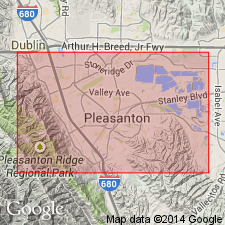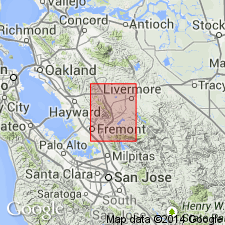
- Usage in publication:
-
- Del Valle formation
- Modifications:
-
- Incidental mention
- AAPG geologic province:
-
- Northern Coast Range province
Summary:
Incidental mention as overlying Niles Canyon formation (new).
Source: US geologic names lexicon (USGS Bull. 1200, p. 1085-1086).

- Usage in publication:
-
- Del Valle formation
- Modifications:
-
- Principal reference
- Dominant lithology:
-
- Sandstone
- Siltstone
- Shale
- Conglomerate
- AAPG geologic province:
-
- Northern Coast Range province
Summary:
Pg. 11-14, fig. 2, geol. map. Del Valle formation. Proposed by Funkhouser (1948, unpub. thesis) for Upper Cretaceous rocks in Arroyo del Valle-Rocky Ridge area of northeastern part of La Costa Valley quadrangle, Alameda County. Name Del Valle formation is applied in this report to rocks along Sunol Ridge in northern part of Niles quadrangle and along western edge of Dublin quadrangle. Rocks along Sunol Ridge cannot be traced into type locality of formation, but they are similar to type section in lithology and age. Thickness along Sunol Ridge, where beds are commonly overturned, may be 3,500 feet; formation thins to the south along ridge. Characteristic lithology is a brown massive soft to hard occasionally concretionary sandstone interbedded with thinly bedded brown siltstone or shale; conglomerate along Sunol Ridge resembles conglomerate of type locality but occurs at top instead of middle of formation. At type locality, brown to reddish-brown hard concretions occur within the sandstone, and cross-bedding and flow structures are common; individual sandstone beds at some localities are massive, whereas elsewhere they are 1 to 10 feet thick, interbedded with 1-inch to 4-foot layers of gray, greenish-gray, or brown shale; lenticular conglomerate near middle of formation is approximately 700 feet thick, thinning to the east. Conglomerate along west side of Sunol Ridge is approximately 600 feet thick; thickness is divided into 50- and 100-foot beds of alternating conglomerate and sandstone; this conglomerate unit was traced into Hayward quadrangle where it occurs below Upper Cretaceous rocks. Conformably overlies Niles Canyon formation; underlies Tolman formation. At type area, where maximum thickness is approximately 9,000 feet, formation is faulted against Franciscan group and Cierbo sandstone and is overlapped by Cierbo sandstone and Livermore gravels. Huey (1948) mapped rocks between Rocky Ridge and Arroyo del Valle as Panoche formation. Funkhouser renamed rocks Del Valle because type locality of Panoche is in Panoche Hills of Fresno County, nearly 100 miles from Arroyo del Valle; also Panoche is not a well-defined unit at its type locality. Age is Late Cretaceous.
Type locality: Arroyo del Valle-Rocky Ridge area of northeastern La Costa Valley quadrangle, Alameda Co., northern CA, where it covers approximately 4 sq mi; extends into Tesla quadrangle.
Source: US geologic names lexicon (USGS Bull. 1200, p. 1085-1086).
For more information, please contact Nancy Stamm, Geologic Names Committee Secretary.
Asterisk (*) indicates published by U.S. Geological Survey authors.
"No current usage" (†) implies that a name has been abandoned or has fallen into disuse. Former usage and, if known, replacement name given in parentheses ( ).
Slash (/) indicates name conflicts with nomenclatural guidelines (CSN, 1933; ACSN, 1961, 1970; NACSN, 1983, 2005, 2021). May be explained within brackets ([ ]).

